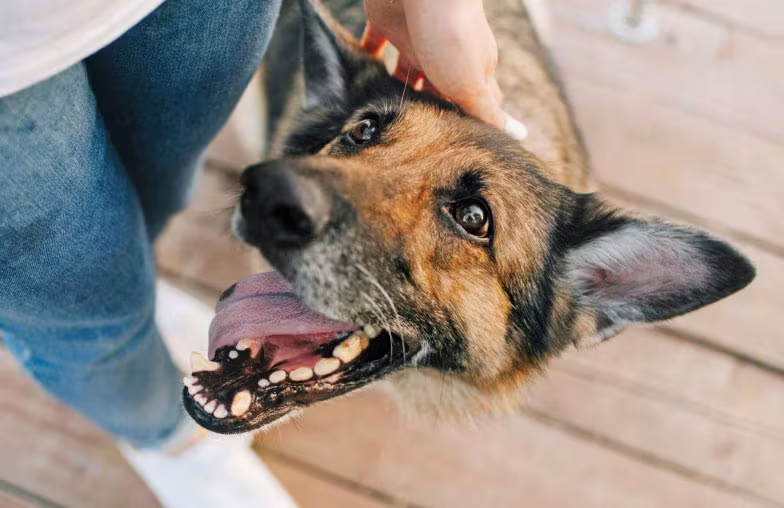Wellness has been a buzzword for several years now. It pops up in conversations about everything from sheet masks and bone broth, to hot yoga and intermittent fasting.
But what does wellness look like for pets? It's very different than it is for humans (no transcendental meditation required).
Physical wellness for them comes down to the essentials: a nutritionally complete diet, regular vet care, exercise, and paying attention to elements like their natural coat, nails, and teeth. And lots of love, of course!
We spoke with our vet experts about pet wellness to find out what you should be focusing on to ensure a happy and healthy future for your four-legged or feathered BFF.
What does “wellness” mean when you're talking about pets?
When terms like “wellness” and “holistic” are used to market human products, brands are often required to ensure they meet certain regulatory stands, says veterinarian Dr. Garrett Schuilenberg. “But we don't really have that for pets.”
So pet parents may want to carefully gauge the ingredients and or benefits of pet products with these labels for furry or feathered family members. (Fortunately, our knowledgeable Animal Care Experts can help you do just that!)
Something you do want to watch out for though is unconsciously applying human wellness standards and needs to animals, he says.
“Our pets are very different. And we have to be cautious about what we apply from our own lives to them. For example, cats can't eat a vegan diet. Maybe that doesn't fall in line with what you personally believe for yourself but there are cases where you can't apply this to pets.”
For Dr. Schuilenberg, pet wellness comes down to a few key elements: diet, regular vet visits, enrichment and exercise, and grooming and maintenance.
Wellness and vet care
“It's a new year and your pet is a year older now, so maybe it's time to start doing annual bloodwork and checkups to make sure that everything's okay,” says Dr. Schuilenberg, as an example of wellness-related actions you can take. “Even if they are feeling completely fine, a routine blood screen can ensure that everything's okay.”
Of course, your best source for wellness assessments and advice is your vet — for everything from checkups to vaccines to preventative medications like flea, tick, and heartworm treatments.
“The younger the pet, the less likely that you're going to run into an issue,” says Dr. Schuilenberg, “but that's not to say that it doesn't happen. It's not to say that routine blood work couldn't catch something that early.”
What might come to light from a vet exam for a younger pet?
“Things that you'd be looking for would have to do with either a genetic issue or some other developmental organ dysfunction. For example, perhaps kidney function maybe wasn't tip-top from birth,” he says.
“There's also different hormonal diseases that start to show up mid-life. There are statistics that dogs as young as two or three years old can start to deal with arthritis. And as far as orthopaedic stuff goes, your young dog's probably pretty active so even physical injuries might be things that start to pop up.”
Dr. Schuilenberg advises pet parents to never underestimate the wellness benefit of a vet visit to make sure you're staying ahead of preventable diseases.
“With vaccinations,” he says, “we're getting our pets vaccinated on time so that they don't get these terrible yet preventable diseases. With regular screening, regular physical exams, and regular blood work, we're checking that they're well, because they can't speak to us. My cat can't tell me if every once in a while he feels stomach pain. I'm not going to know that that's happening unless I take him to the vet and someone actually checks.”
Wellness and diet
Diet plays a major role in overall pet wellness.
“Food is huge,” says Dr. Schuilenberg. “Feeding something that is complete and balanced,” he explains, makes all the difference. And that applies to whatever style of diet you decide to feed your pet — raw, wet, or kibble.
“You need to make sure that their diet is completely balanced. It needs to have everything that they need. That's not just looking at it and thinking ‘Oh, there's a green vegetable and there's meat and there's carbohydrates here, so that must be it.'”
Dr. Schuilenberg says, animals have “very specific nutritional requirements — macronutrients, micronutrients, things like that. What I'm getting at here is that kibble is wellness. Dog food that is made for dogs is wellness. It's stuff that has been tested, stuff that has everything in it. Those are the things that you should be feeding your pet for its entire lifetime. Sure, you can switch them up, but they should always be completely balanced.”
When in doubt, pet parents should read the packaging and if the food is complete and balanced it will say so on the label.
If your pet has digestive issues or if you and your veterinarian have decided on specific goals for their diet (for example, weight loss or weight maintenance), vet-prescribed foods might also become part of your pet's wellness routine.
Prescription diets differ from store-bought ones, in that they focus on nutrigenomics — the way diet interacts with a pet's genes and influences their metabolism — and really hone in on specific nutrient balances. These products contain ingredients that can stimulate an animal's metabolism or alter the way they digest different foods to encourage weight loss or address other health issues. Prescription diets are only available at your veterinary clinic and there are no equivalent alternatives sold in pet stores.
For weight loss, “commercial brands have lower calories in them, essentially,” explains Dr. Schuilenberg, which may suffice for some pets who need to work at maintaining a healthy weight. Our Performatrin line also has weight-loss solution food, but other wellness concerns may necessitate vet-prescribed foods.
“Beyond weight loss foods, we have diets for kidney disease, for liver disease and for various other issues like that, that restrict certain ingredients or have more of certain ingredients to be able to help manage those issues.”
In general, pets don't require products like these, but there are of course exceptions to this rule.
Dr. Schuilenberg says that for animals who are developing arthritis, a glucosamine or omega-3 supplement is safe for most pets and can help with joint stiffness and pain. “Omega-3s are kind of good for everything,” he says.
“They're a general anti-inflammatory. So they help with brain health, they help with cardiac function, they're good for arthritis, and they help increase the strength of the skin barrier which can help with a lot of skin diseases. There are a lot of cases where you would use omega-3s.”
Yes, there are other situations in which your pet might require a supplement, but that's best determined in consultation with your vet, to figure out which type of supplement they need, how much they should take in a single dose, and how often they should be receiving it.
Wellness and oral health
You brush your pet's fur, bathe them, and clip their nails, but do you brush their teeth? Good oral health is a sign of overall health and is “extremely important,” according to our vet experts.
Dental care is a big deal for your pet. The bacteria that forms in their mouths has the potential to migrate into their bloodstream and have a negative impact on their organs. So consider it a key element of the physical care you provide.
“Brushing your dog's teeth, using dental treats, and using dental supplements is very important to help slow the progression of plaque and tartar down and decrease the chances of developing severe dental disease,” says Dr. Schuilenberg, who adds that regular dental care from a professional should also factor into your pet's wellness routine.
“Brushing your pet's teeth doesn't preclude going to the vet,” he adds. You're still going to have to get them dental checkups, you're still going to potentially have to get their teeth cleaned. And because genetics play a role, just like they do in people, a pet may still ultimately have to get some teeth pulled.”
Just as with vaccines and regular check-ups, prevention is the goal when it comes to pet dental hygiene.
An indicator there may be a problem is bad breath. Dogs should not have bad breath — it isn't natural. It is actually one of the first signs of periodontal disease, which is a painful condition that can affect your pet's appetite and quality of life.
You are most likely to be successful with brushing if you begin doing it early on in the life of your pet. Getting a puppy used to toothpaste and a brush is generally easier than convincing a four-year-old dog to adopt a new habit.
No matter how old your pet is though, says veterinarian Dr. Jean Gauvin, the most important thing is to approach brushing with an abundance of patience.
“Don't get the toothbrush out first,” he advises. “Put your toothpaste on your finger and just give it to the dog like a treat. It's only once the dog is used to the toothpaste that you put the toothpaste on the brush, let him lick it, and then eventually gently start [brushing].”
Taking slow, incremental steps towards your ultimate pet teeth-cleaning goals will prevent your dog from getting stressed out by the process, and developing a negative reaction to the mere sight of a toothbrush.
“If your dog is afraid of the procedure and takes off every time he sees you get the toothpaste or toothbrush out, it's not going to work,” he says. “You won't like it, either. It shouldn't be a chore.”
Smaller dogs, and teeth-brushing alternatives
For smaller dogs (and their smaller mouths) brushing may not work at all, no matter how much patience you bring to the table. Ironically, they're the pets most likely to require serious dental attention.
“Vets will say that smaller breeds have more dental issues than larger breeds,” says Dr. Gauvin, despite the fact that all dogs, regardless of jaw size, have the same amount of teeth. “In smaller dogs, the teeth will be crowded and crooked, and this will promote the accumulation of food between the teeth.”
Brushing is always best, but for a small or uncooperative dog you can try different products instead. Dental wipes can be easier to move around inside small mouths. And dental sprays, gels, and foams are great for reaching the back corners of your pet's mouth, while water additives work to reduce plaque and tartar every time your pet takes a drink.
Dental treats can also be a great addition to your teeth-cleaning routine. “Mechanical” dental treats work to physically clean teeth, while treats with active ingredients have the added benefit of helping to prevent plaque.
When shopping for dental care products for your pet, be sure to look for items that have been tested and deemed effective by trustworthy sources. Avoid ones that simply promise to freshen breath — that's only masking a problem rather than helping to fix or prevent one.
















































